
Willows, also called sallows and osiers, form the genus Salix, are around 400 species of deciduous trees and shrubs, found primarily on moist soils in cold and temperate regions of the Northern Hemisphere. Most species are known as willow, but some narrow-leaved shrub species are called osier, and some broader-leaved species are referred to as sallow. Some willows are low-growing or creeping shrubs; for example, the dwarf willow rarely exceeds 6 cm (2.4 in) in height, though it spreads widely across the ground.

Salix discolor, the American pussy willow or glaucous willow, is a species of willow native to North America, one of two species commonly called pussy willow.

Endoclita is a genus of moths of the family Hepialidae. There are 60 described species found in eastern and southeast Asia and the Indian subcontinent.
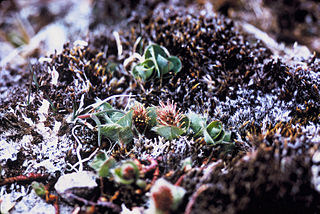
Salix arctica, the Arctic willow, is a tiny creeping willow. It is adapted to survive in Arctic conditions, specifically tundras.

Salix caroliniana, commonly known as the coastal plain willow, is a shrub or small tree native to the southeastern United States, Mexico and parts of Central America and the Caribbean. It is an obligate wetland species and grows as an emergent species in the Everglades. In the absence of fire, S. caroliniana can convert herbaceous wetlands to forested wetlands. Although fires kill large woody stems and the species does not reproduce by rhizomes or root sprouts, it sprouts readily after fire. As a result, the total number of stems does not change, but fire converts S. caroliniana from a tree into a shrub.
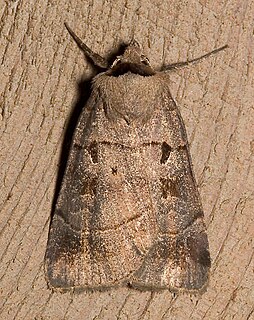
Agnorisma badinodis is a moth of the family Noctuidae. It is found in southern Canada and United States, east of the 100th meridian, and exclusive of the Deep South.

The triple-spotted clay is a moth of the family Noctuidae found in most of Europe, northern Turkey, northern Iran, Transcaucasia, Caucasus, central Asia, from the Altai to Ussuri, Amur, Kuril Islands, northern Mongolia, Tibet, China, Korea, and Japan.

Acleris hastiana is a moth of the family Tortricidae. It is found in Europe, northern Iran, Kazakhstan, Ala Tau, central Siberia, Irkutsk, the Amur region and China. In North America it is found from the north-eastern United States across southern Canada to British Columbia and south along the Pacific Coast to California.
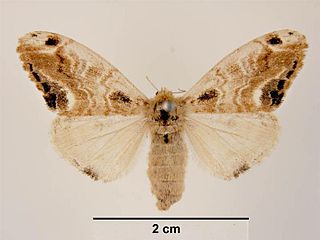
Orgyia thyellina, the white-spotted tussock moth, is a species of moth of the subfamily Lymantriinae first described by Arthur Gardiner Butler in 1881. It is native to the Russian Far East, Japan, Korea, Taiwan, and China. It was discovered in Auckland, New Zealand, in 1996. Operation Ever Green was established that same year to eradicate the pest. By 1998, the species was eradicated. It is thought of as one of the most successful eradication programmes ever undertaken in an urban area.
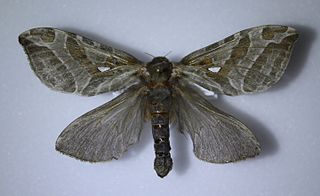
Sthenopis argenteomaculatus, the silver-spotted ghost moth, is a species of moth of the family Hepialidae. It was described by Thaddeus William Harris in 1841, and is known in North America from Nova Scotia to Virginia and west to Minnesota.

Sthenopis pretiosus, the gold-spotted ghost moth, is a species of moth of the family Hepialidae. It was first described by Gottlieb August Wilhelm Herrich-Schäffer in 1856. It can be found in found Brazil, Venezuela and in the north-eastern United States and south-eastern Canada.
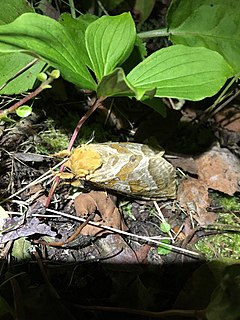
Sthenopis purpurascens, the four-spotted ghost moth, is a species of moth of the family Hepialidae. It was described by Packard in 1863. It is found in Canada and the United States, from Labrador and New York north and west to British Columbia and the Northwest Territories, south in the mountains to Arizona.

Sthenopis thule, the willow ghost moth, is a species of moth of the family Hepialidae. It was described by Strecker in 1875, and is known from Canada and the United States, including Ontario, Quebec and Saskatchewan.
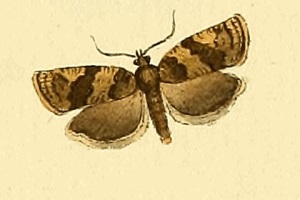
Choristoneura diversana is a species of moth of the family Tortricidae. It is found in Great Britain, France, Belgium, the Netherlands, Germany, Denmark, Austria, Switzerland, Italy, the Czech Republic, Slovakia, Slovenia, Poland, Bulgaria, Hungary, Romania, Norway, Sweden, Finland, the Baltic region, Russia and the Near East. In the east, the range extends to China (Heilongjiang), Korea and Japan. The habitat consists of gardens, scrub and fens.
The Silver Ghost is a model of Rolls-Royce automobile.














